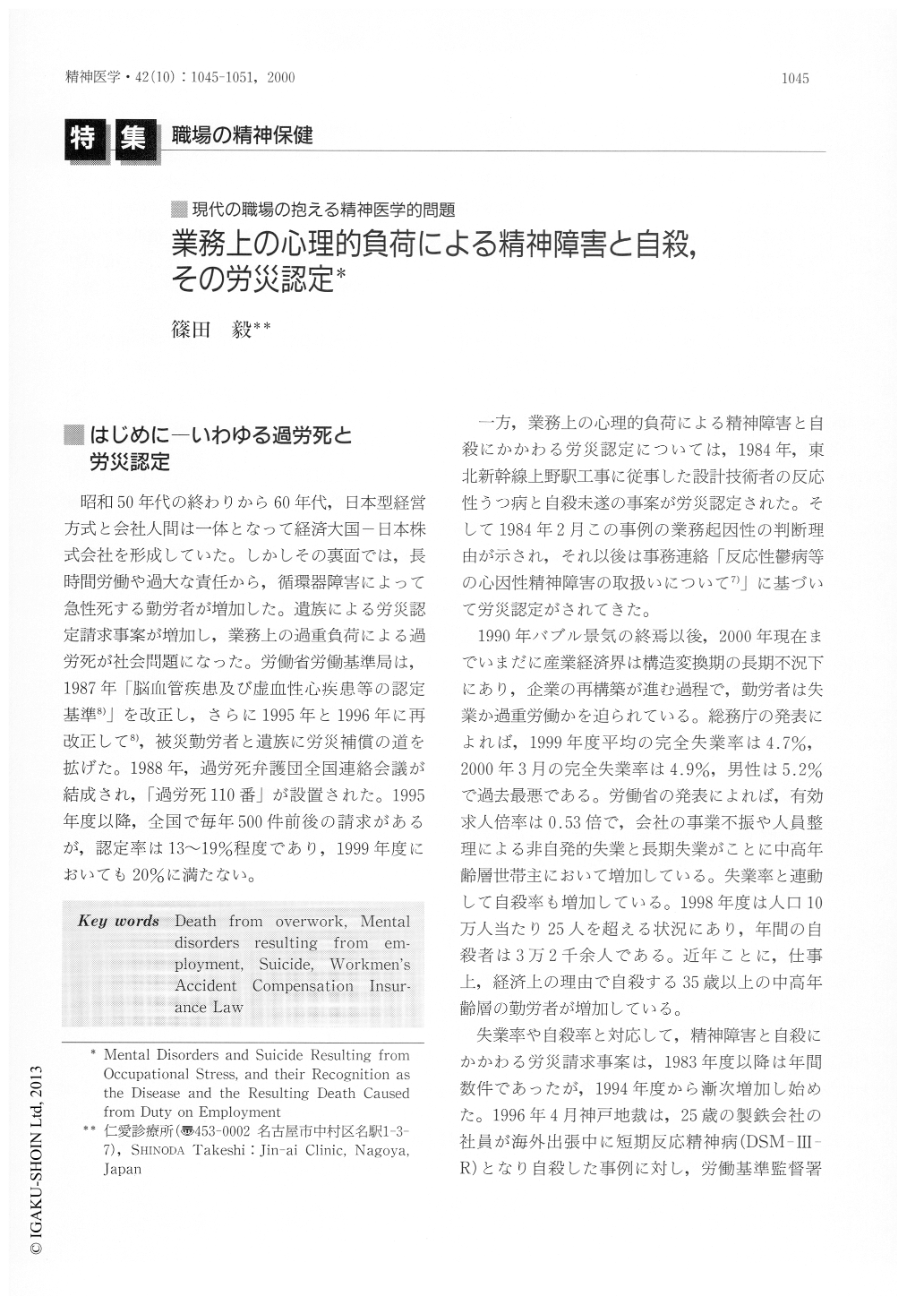1 0 0 0 業務上の心理的負荷による精神障害と自殺,その労災認定
- 著者
- 篠田 毅
- 出版者
- 医学書院
- 雑誌
- 精神医学 (ISSN:04881281)
- 巻号頁・発行日
- vol.42, no.10, pp.1045-1051, 2000-10-15
はじめに—いわゆる過労死と労災認定 昭和50年代の終わりから60年代,日本型経営方式と会社人間は一体となって経済大国一日本株式会社を形成していた。しかしその裏面では,長時間労働や過大な責任から,循環器障害によって急性死する勤労者が増加した。遺族による労災認定請求事案が増加し,業務上の過重負荷による過労死が社会問題になった。労働省労働基準局は,1987年「脳血管疾患及び虚血性心疾患等の認定基準8)」を改正し,さらに1995年と1996年に再改正して8),被災勤労者と遺族に労災補償の道を拡げた。1988年,過労死弁護団全国連絡会議が結成され,「過労死110番」が設置された。1995年度以降,全国で毎年500件前後の請求があるが,認定率は13〜19%程度であり,1999年度においても20%に満たない。 一方,業務上の心理的負荷による精神障害と自殺にかかわる労災認定については,1984年,東北新幹線上野駅工事に従事した設計技術者の反応性うつ病と自殺未遂の事案が労災認定された。そして1984年2月この事例の業務起因性の判断理由が示され,それ以後は事務連絡「反応性欝病等の心因性精神障害の取扱いについて7)」に基づいて労災認定がされてきた。 1990年バブル景気の終焉以後,2000年現在までいまだに産業経済界は構造変換期の長期不況下にあり,企業の再構築が進む過程で,勤労者は失業か過重労働かを迫られている。総務庁の発表によれば,1999年度平均の完全失業率は4,7%,2000年3月の完全失業率は4.9%,男性は5.2%で過去最悪である。労働省の発表によれば,有効求人倍率は0.53倍で,会社の事業不振や人員整理による非自発的失業と長期失業がことに中高年齢層世帯主において増加している。失業率と連動して自殺率も増加している。1998年度は人口10万人当たり25人を超える状況にあり,年間の自殺者は3万2千余人である。近年ことに,仕事上,経済上の理由で自殺する35歳以上の中高年齢層の勤労者が増加している。
1 0 0 0 OA 腱板断裂肩と健常肩における位置覚の検討
- 著者
- 萩尾 友宣 柴田 陽三 篠田 毅 伊崎 輝晶
- 出版者
- 日本肩関節学会
- 雑誌
- 肩関節 (ISSN:09104461)
- 巻号頁・発行日
- vol.35, no.3, pp.837-840, 2011 (Released:2011-12-21)
- 参考文献数
- 9
Proprioception was studied in rotator cuff tear and normal shoulder using active angle reproduction test. Subjects and methods: In cuff tear group(RCT), 33 cases (33 shoulders) were studied. They were 19 males and 14 females, their average age was 66.4 years.The average active elevation angle was 112.4° and the average external rotation angle was 51.4°. As a control group (C), 20 cases (20 shoulders) who had not had previous injury or disease in their shoulder were studied. Average elevation angle was 160.3° and average external rotation angle was 61.9°. The subjects were studied sitting on a chair and had a bandage put over their eyes. They rotate or elevate their shoulder to any angle. The difference absolute values between average of 3 times of reproduction of the angle and the target angle were studied. The target angles were 30° of internal rotation, 30° and 45° external rotation, 30°, 45° and 60° of elevation. In 30° of IR, error angle revealed 7.0° in RCT and 2.6° in C group (P<0.01). These were 4.6° and 2.5°(P<0.01) in 30° of ER, 3.6° and 2.5°(P=0.15) in 45° of ER. These were 4.0° and 2.1° in 30° of elevation (P<0.05), 4.1° and 1.9° in 45° of elevation (P<0.01), 4.8° and 2.4° in 60° of elevation(P<0.01). Proprioception of rotator cuff tear was lower than that of normal shoulder.
